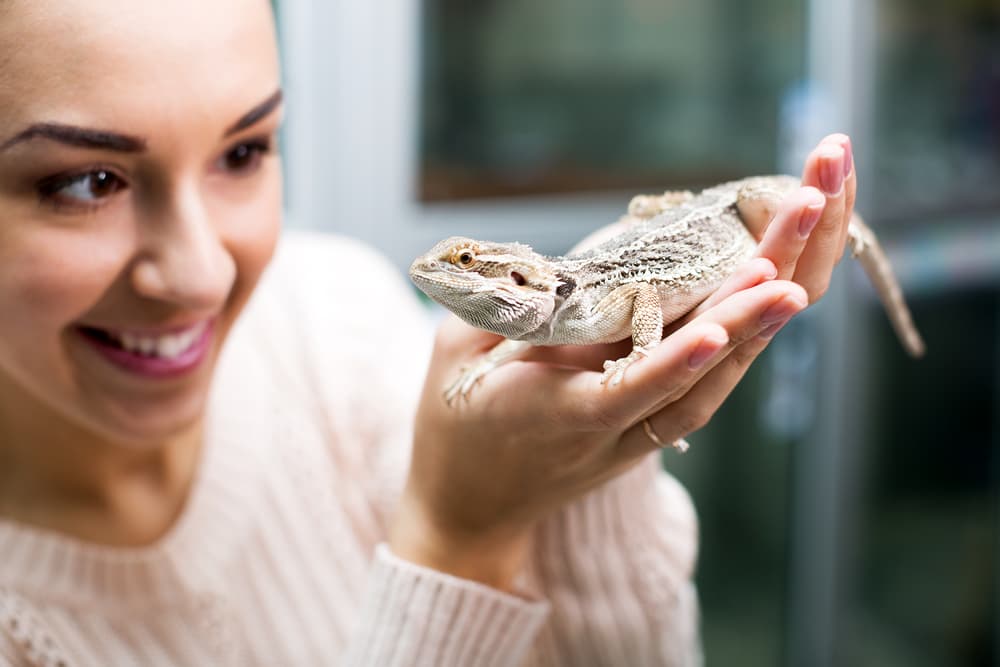Lizards are among the most popular reptile pets, but be prepared for a long-term commitment. A blue-tongue lizard can live for 20 years!
These pets also have detailed daily requirements to keep them healthy.
Our guide to caring for your first lizard will set you on the right path.
Obtaining a wildlife licence
It’s illegal to take native reptiles from the wild, so you must obtain them from a licensed breeder. You will need a wildlife licence to keep a lizard. Requirements vary across Australia so check with your state wildlife authority.
Finding a food source
Most lizards are omnivores. This diet requires a mixture of meat, fruit and vegetables and live prey such as crickets or mealworms. Pet shops also offer a range of pelleted foods, along with calcium, vitamin and mineral supplements.
Food and water should be placed in shallow containers. Some lizards prefer a drip system for water.
Creating a safe and healthy habitat
Lizards are usually kept in an escape-proof vivarium made from wood, glass or plastic. These enclosures usually open from the front for easy cleaning, and some come with lighting and heating already installed.
Here are a few tips for creating the right habitat.
- Find out how large your lizard will grow to ensure you buy the correct sized vivarium. Also consider the best shape: low and wide for most lizards or tall and narrow for tree dwellers such as dragons and monitors.
- Place absorbent substrate in the vivarium to keep your lizard clean and dry. Options include sand, leaf litter, bark chips or even reptile carpet. If your lizard likes to burrow, provide a deeper layer suited to burrowing.
- Recreate the natural environment. Lizards enjoy climbing, baking and hiding so use branches, logs, bark and rocks to encourage these activities. Lean a branch against the side wall for climbers, add a perch, or a larger rock for basking in the warmth.
- Watching your pet can be fascinating so it’s tempting to remove materials that allow your lizard to hide. But hiding is an important natural behaviour. Without hiding places, your lizard can feel unsafe and stressed. Try making a hiding place near the side of the enclosure. Hollow logs, large pieces of bark, cardboard boxes or commercially made caves will hide your pet but still allow you to observe them.
- Cold-blooded critters need a heat source to help regulate their body temperature, digest food and stay active. Your vivarium should have a thermo-gradient. This means it should be warmer at one end and cooler at the other to allow your lizard to self-regulate their temperature. For most reptiles, the thermo-gradient should range from about 18 through to 32 degrees. Heating options include basking bulbs, infrared heat lamps and heat mats.
- Install a light source to reflect the lizard’s natural day-night cycle. According to the NSW Office of Environment & Heritage, a cycle of 10 hours of light and 14 hours of dark is appropriate for reptile enclosures without access to a natural seasonal day-night cycle. Options such as full spectrum fluorescent UVA/UVB tube lamps provide light while full spectrum incandescent lamps provide light and heat.
- Good hygiene is essential for good health. Don’t let uneaten food, urine and faeces build up in the enclosure. Clean and disinfect food and water containers regularly.
Deciding on giving your lizard company
It's a good idea to seek advice from a vet before keeping more than one lizard in the same vivarium. Not all lizards are sociable in the first place, and different species tend to require slightly different care, which can make it difficult to keep everyone healthy and happy.
Monitoring your interaction
While many pets enjoy snuggling with their owners, reptiles don’t crave human contact. They can be attentive to your activities, but they are also content when left alone.
Handling your lizard too much can cause them stress. Young lizards are particularly vulnerable to overhandling or changes to their environment.
Always use hand sanitiser after handling your pet. Lizards can transfer bacteria such as salmonella to humans.
It's also a good idea to find a vet clinic with a reptile care specialist, and keep notes on feeding patterns, shedding, general health and any unusual behaviour.
Caring for your first lizard can be a rewarding experience. Following our guide will give you confidence in keeping your new companion healthy and happy.






























